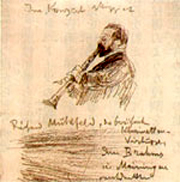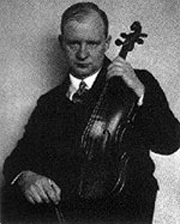Trivia
Viola masterpieces: Chamber music
From the beginning of the Baroque period to the middle of the same period (c. 1700), many chamber music pieces and ensembles were composed in five parts, with the middle three parts played mainly by the viola. From the latter Baroque period, most orchestra string concerts had a four-part structure (violin for two parts, viola for one part, and then bass for one part), and sonatas/trio sonatas for violins became popular even in chamber music, so there were fewer and fewer violas used in this kind of composition. Violas were once again used in chamber music from the classical period.
W.A. Mozart: Trio in E-flat for Viola, Clarinet, and Piano
This unusual piece was composed for a stringed instrument, woodwind instrument, and keyboard instrument, and is sometimes called the "Kegelstatt Trio." "Kegelstatt" is a sport that is similar to modern-day bowling, and it is said that Mozart composed this piece due to his fondness of the sport. It is also said that he wrote the piece to be performed during a concert for the Jacquin family, which were friends of his. Mozart himself may have even played the viola during this performance. The beautiful melodies of the three instruments harmonize wonderfully and at times develop into a back-and-forth clashing-truly music that could only have come from the mind of Mozart.
J. Brahms: Sonata for Viola and Piano
Brahms left behind two sonatas for clarinet and piano (in F minor and E-flat major). These are also often played on viola. They were originally written for Richard Muhlfeld, a member of the Meiningen Court Orchestra who was said to be the greatest clarinet player of the time. However, the clarinet and viola have a similar range, and if the piece is played with a viola you would never expect that is was not written for the instrument. Both pieces feature sad and gloomy melodies, which are perfect to demonstrate the charms of the viola.

P. Hindemith: Sonata for Solo Viola
Paul Hindemith, a German composer active during the first half of the 20th century, was also a violist, and he wrote a total of seven viola sonatas (three of which were for viola and piano). Here, we introduce the final solo viola sonata he wrote in 1937. This sonata was composed while Hindemith was traveling by train from New York to Chicago. It's composed of four sections, and it makes expert use of the characteristics of the viola as a solo instrument, from its bitter monologue to its intense polyphony. Hindemith at this time had left Germany due to Nazi persecution, and ultimately had no choice but to immigrate to the United States. This sonata likely expresses the emotional malaise he was feeling at the time.

Hindemith was also a violist
Musical Instrument Guide : Violin Contents
Origins
Structure
How to Play
How the Instrument is Made
Choosing an Instrument
Care and Maintenance
Trivia
- The f-hole used to be a C-hole or S-hole
- Why the f-hole?
- Violinists must bow to the horse
- Steel strings or gut strings? That is the question
- Is the chinrest the unsung hero of the violin?
- Most violin varnishes are also medicines
- Violin masterpieces: Solos I
- Violin masterpieces: Solos II
- Violin masterpieces: Solos III
- Violin masterpieces: Concertos I
- Violin masterpieces: Concertos II
- Viola masterpieces: Chamber music
- Viola masterpieces: Concertos
- Cello masterpieces: Concertos I
- Cello masterpieces: Concertos II
- Cello masterpieces: Solos
- Contrabass masterpieces: Concertos
- Contrabass masterpieces: Chamber music
- Orchestral masterpieces featuring the contrabass
- What do you call the part on the bow that you hold?
